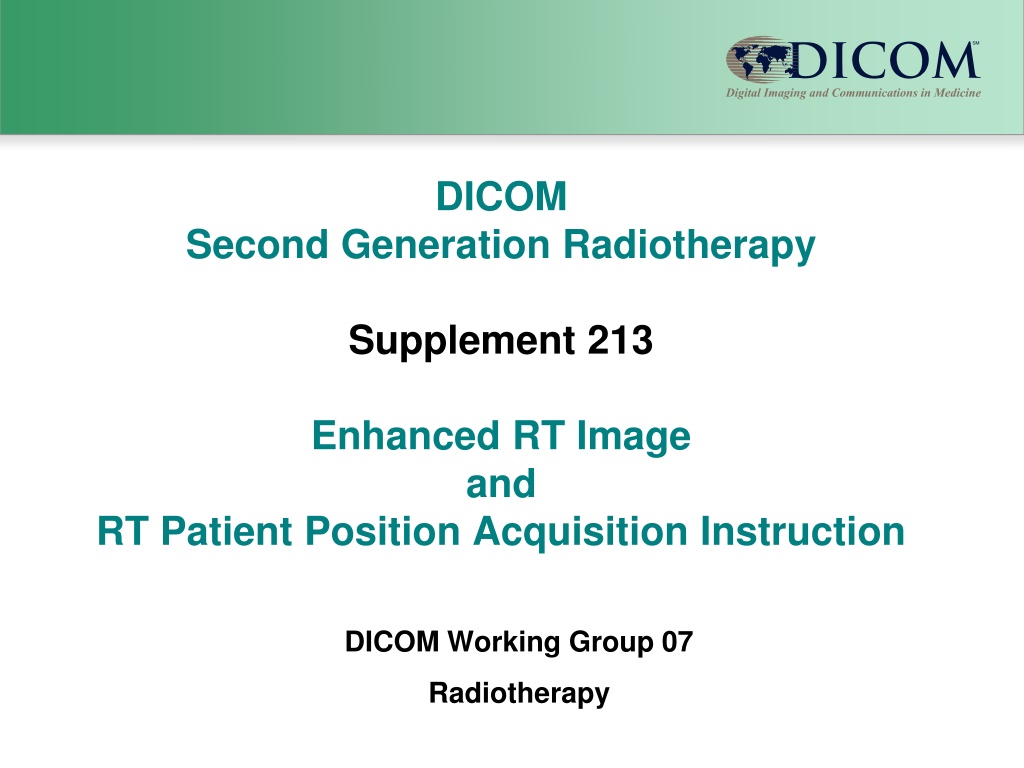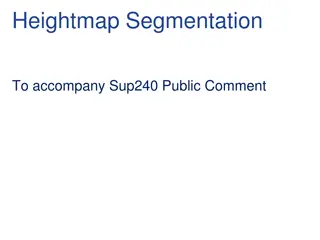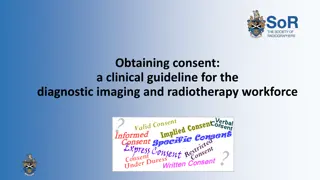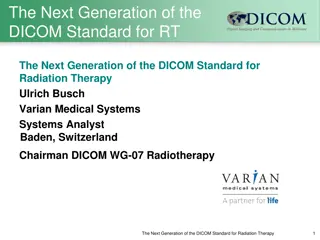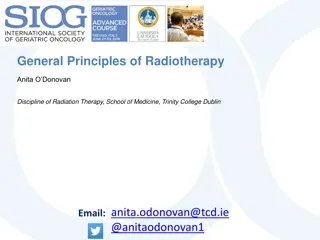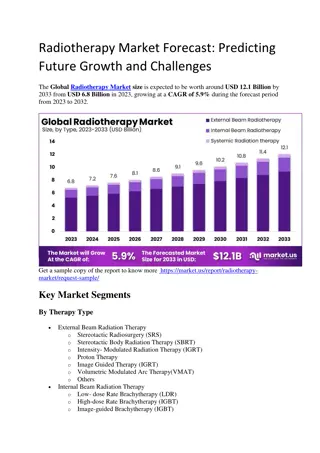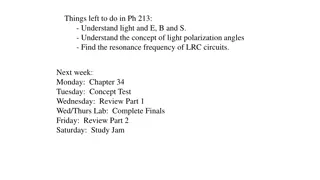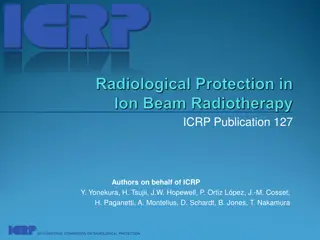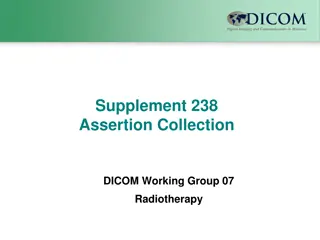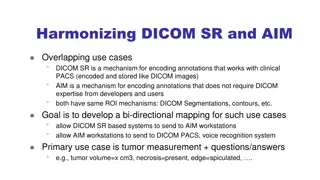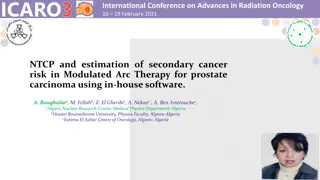Comprehensive Overview of DICOM Second Generation Radiotherapy Supplement 213
This content delves into the enhanced RT imaging and patient position acquisition instructions provided by the DICOM Working Group 07 for radiotherapy. It covers the scope of Supplement 213, including various imaging technologies and instructions for acquisition devices. The content outlines the IODs for RT image enhancement, patient position acquisition, and the functional scope of RT images. It also discusses the clinical role of RT images in representing images acquired before, during, and after therapeutic radiation, as well as patient position detection and correction.
Download Presentation

Please find below an Image/Link to download the presentation.
The content on the website is provided AS IS for your information and personal use only. It may not be sold, licensed, or shared on other websites without obtaining consent from the author. Download presentation by click this link. If you encounter any issues during the download, it is possible that the publisher has removed the file from their server.
E N D
Presentation Transcript
DICOM Second Generation Radiotherapy Supplement 213 Enhanced RT Image and RT Patient Position Acquisition Instruction DICOM Working Group 07 Radiotherapy
Supplement Scope Radiotherapy Imaging for Patient Position Detection: Various imaging technologies result in various IODs Advice to Procedure Execution: Acquisition Devices are instructed about details of Acquisition Scope of Supplement 213 in red Technology Result IODs Acquisition Instruction IOD Projection / RT Image Enhanced RT Image -> Sup 213 Included -> Sup 213 CT CT Included -> Sup 213 MR MR Future Extension Ultrasound US Future Extension Surface Scanning Surface Future Extension Transponder Marker Segmentation, Fiducials Future Extension Future Extension others others 2
Supplement Content 2 IODs for RT Image Enhanced RT Image Enhanced Continuous RT Image 1 Instruction IOD RT Patient Position Acquisition Instruction Several Macros Applicability (to RT Radiation Sets, RT Radiations ) Geometry (Image Source and Receptor in respect to Equipment) Signal Generation (KV, MV, later: others) Usage across all 3 IODs: RT Image IODs: Recording parameters used during acquisition Instruction IOD: Specifying parameters to be used during acquisition 3
RT Image Functional Scope (substantially same scope of content as in 1st Generation) Image Characteristics Projection Image May be: Single Frame Couple of Frames Continuous acquisition (MPEG) 4
RT Image Clinical Role Image Object may represent Images acquired before / during / after therapeutic Radiation Images re-constructed from 3D Images prior to Treatment DRRs , Reference Images , constructed in Treatment Planning phase Used for verification: Comparison against acquired Images DRR Acquired 5
RT Image Clinical Role Patient Position Detection and Correction Acquire RT Image with patient on table. Relate current Patient Position in respect to treatment device Determine correction of Patient Position: Determine current beam geometry in respect to patient Relate current beam geometry to planned beam geometry (in respect to patient) - as needed - Align position and orientation of patient to match planned beam geometry RT Image provides well-defined path of geometric calculation: From: treatment beam in device coordinates To: Patient FOR For various type of treatment devices Crucial for correct placement of therapeutic radiation 6
RT Image Clinical Role Patient Position Monitoring RT Images acquired during Therapeutic Radiation Delivery With various frequencies / trigger points Various Modes of Use, namely During-treatment observation Ensure that position stays within certain limits Post-Treatment Monitoring To verify, that the position was within limits Assess amount of motion 7
Functional Requirements Geometric Content Generalized description of geometric relation of Image to Treatment device to Patient positioning device Therapeutic Beam-related Content State of Device where the Image relates to: Meterset / Time Related to device states (e.g. gantry rotation, collimation etc.) Description of Beam Modifiers in generalized approach of 2nd Gen Therapeutic Context RT Radiation, RT Radiation Set Treatment Session and Treatment Fraction 8
Why 2nd Generation? Use of 2nd Gen concepts RT Image Context to RT Radiation Sets, RT Radiations Using Equipment Coordinate System Generalizing geometry specification to handle variety of Imaging devices and Treatment Device geometries re-use Macros Using 2nd generation macros to describe Patient Position, Beam Modifiers, Radiation re-use Macros Use of Enhanced Multi-Frame Approach Benefit from Multi-Frame Functional Groups formalism Stay in line with current Multi-Frame of other IODs Cleaning up / strengthening / expanding the historically grown patchy structure and representation of 1st Gen RT Image IOD Footer Text 9
Part of 2nd Generation RT 2nd Gen Use of application of Equipment FOR and Patient FOR Radiation Source Well-Known Frame of Reference: Device-Specific Room Coordinate System (e.g. IEC Fixed System) Device-Specific Parameters E.g. Roll (Gantry) Angle, BLDs Patient To Device Transformation Matrix Image-based Frame of Reference E.g. Planning CT, Acquired CT Fixed Room System (Building) 10
Acquisition Instruction RT Patient Position Acquisition Instruction IOD Contains specification for (as applicable): RT Patient Support Device Position Specified Position in respect to Equipment Coordinate System at which acquisition shall be performed Acquisition Device Position Positions of Acquisition Devices in respect to Equipment Coordinate System when artifacts are acquired Acquisition Execution Parameters Parameters to be used when artifacts are acquired Acquisition Triggers Specifies when devices should perform the acquisition Current Coverage in Supplement 213: MV / KV, Projection and Volumetric Image Acquisition Other modalities / technologies may be added to this IOD by future supplements IOD designed for extensibility Footer Text 11
RT Pat. Position Instruction Task Index / Workitem Code Applicability Scope References to Radiation Instances / Treatment Groups Subtask (1-n) Index / Specialized Workitem Code Acquisition Template Identifier Baseline Radiation Reference RT Device Distance Reference Acquisition Initiation Source Signal Generation - kV Generation - MV Generation RT Device to Patient Geometry - Projection Imaging Geometry - 3D Imaging Geometry Device-Specific Parameters Additional Devices / Parameters Position Reference Instances 12
One Subtask Example Workitem Code = (121702, DCM, RT Patient Position Acquisition, single plane MV ) Task Applicability Scope = RT Radiation AP Index = 1 Workitem Code = (121702, DCM, RT Patient Position Acquisition, single plane MV ) Subtask 1 Acquisition Initiation = (S213504, 99SUP213 Acquisition Initiation at specified value ) (Start Paramater) = (S213520, DCM, "Meterset") = 10 MU MV Generation = 6 MV Projection Geometry = Gantry Angle 0 Position Reference Instance = RT Image AP 13
Two Subtask Example kV/kV Workitem Code = (121705, DCM, RT Patient Position Acquisition, dual plane kV ) Task Applicability Scope = RT Radiation AP Index = 1 Workitem Code = (121704, DCM, RT Patient Position Acquisition, single plane kV ) Subtask 1 Acquisition Initiation = (S213502, 99SUP213 Acquisition Initiation before start of Radiation ) kV Generation = 80 kV Projection Geometry = Source Angle 0 Position Reference Instance = RT Image AP Index = 2 Workitem Code = (121704, DCM, RT Patient Position Acquisition, single plane kV ) Subtask 2 Acquisition Initiation = (S213502, 99SUP213 Acquisition Initiation before start of Radiation ) kV Generation = 80 kV Projection Geometry = Source Angle 90 Position Reference Instance = RT Image LATR 14
Two Subtask Example kV/MV Workitem Code = (121706, DCM, RT Patient Position Acquisition, dual plane kV/MV ) Task Applicability Scope = RT Radiation AP Index = 1 Workitem Code = (121704, DCM, RT Patient Position Acquisition, single plane kV ) Subtask 1 Acquisition Initiation = (S213502, 99SUP213 Acquisition Initiation before start of Radiation ) kV Generation = 80 kV Projection Geometry = Source Angle 90 Position Reference Instance = RT Image LATR Index = 2 Workitem Code = (121702, DCM, RT Patient Position Acquisition, single plane MV ) Subtask 2 Acquisition Initiation = (S213502, 99SUP213 Acquisition Initiation before start of Radiation ) MV Generation = 6 MV Projection Geometry = Source Angle 0 Position Reference Instance = RT Image AP 15
Acq Instr: Tasks to perform One or more Acquisition Tasks For example: Task 1: One KV/MV Image pair prior to therapeutic beam Task 2: 5 MV Images during beam Task 3: One KV Image after beam A task applies to: a set of RT Radiation Sets or a set RT Radiations or a Treatment Position group. One or more Subtasks per Task. Per example of above: Task 1: 2 subtasks: one for KV, one for MV Task 2: 1 subtask for MV, with 5 trigger values defined Task 3: 1 subtask for MV Footer Text 16
Acq Instr: Specification Approaches Parameters are specified by: Indirectly by Protocol Refer to a protocols knows to the acquisition device by Code, or by ID User may fine-tune this protocol at the acquisition device any time Protocol identification stays the same Protocol Version tracking out of scope Device based settings may be traced locally at the device Directly by explicit Parameters: As indicated in the following slides Any combination of Protocol-inferred and explicit Parameters supported Addresses variability of devices in terms of Technology Generation Footer Text 17
Acq Instr: Geometry Basis: Equipment FOR Same approach as used for RT Radiation IODs as well Device Geometries Transformation Matrix from Equipment FOR to Imaging Source Coordinate System Image Receptor Coordinate System User-readable decomposition optionally supported for applications, which can t do this concept as used in RT Radiations as well Patient Positioner Geometry Use of existing 2nd Generation Approach Relate Patient FOR to Equipment FOR Library Approach Specify Patient Position once Apply many times by reference, since most treatments have static positions, but some do not Footer Text 18
Acq Instr: Signal Generation Generation of MV (therapeutic) Beam for Imaging Use of 2nd Gen Radiation Generation Macro Covers MV Photons and Particles Incl. all beam generation specifics for the therapeutic beam devices Generation of KV (therapeutic) Beam for Imaging Use of existing (KV) X-Ray Attributes Covers KV Photons (future outlook: Addition of other technologies as needed) Footer Text 19
Contacts Christof Schadt Co-Chair WG-07 Brainlab AG christof.schadt@brainlab.com Jim Percy Co-Chair WG-07 Elekta jim.percy@elekta.com Ulrich Busch (Editor) Member WG-07 Individual ulrich.busch@bluewin.ch
